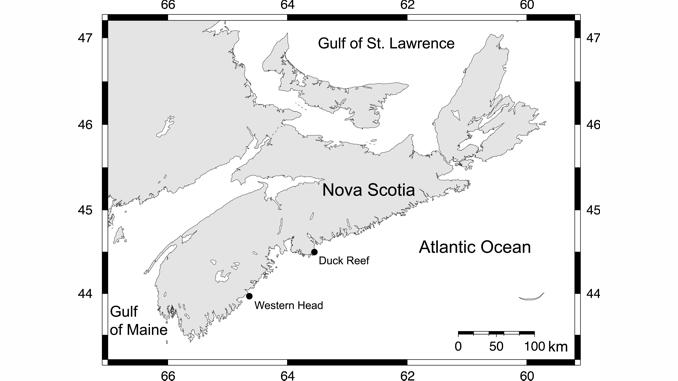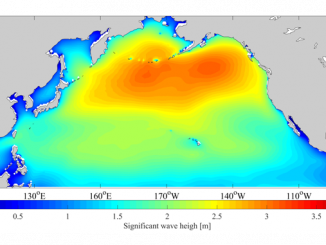
Paper category: Short communication
Corresponding author: Ricardo A. Scrosati (rscrosat@stfx.ca)
DOI: 10.1515/ohs-2020-0008
Received: 25/03/2019
Accepted: 24/06/2019
Full text: here
Citation (APA style): Scrosati, R. & Ellrich, J. (2020). Marked contrast in wind-driven upwelling on the southeastern Nova Scotia coast in July of two years differing in ENSO conditions. Oceanological and Hydrobiological Studies, 49(1), pp. 81-87. Retrieved 10 Mar. 2020, from doi:10.1515/ohs-2020-0008
Abstract
Upwelling occurs on several coasts of the world, but it has mostly been studied on eastern ocean boundaries. We investigated upwelling on a western ocean boundary for which limited information exists. Using daily in-situ data on sea surface temperature (SST), we found a marked contrast in coastal cooling between July 2014 (pronounced) and July 2015 (weak) at two locations 110 km apart on the Atlantic coast of Nova Scotia, Canada. These findings are consistent with a marked interannual difference in wind-driven upwelling. On the one hand, southwesterlies (which cause upwelling on this coast) were more frequent in July 2014 than in July 2015. On the other hand, Bakun’s upwelling index (which is based on wind data and geographic information) indicated that coastal upwelling was more common and intense in July 2014 than in July 2015, while the reverse was true for downwelling. Interestingly, a strong El Niño event occurred in July 2015, while no El Niño (or La Niña) conditions happened in July 2014. In a recent book evaluating upwelling systems around the world, the system that is the focus of the present study was not included. Therefore, our findings should stimulate future research on upwelling on the Atlantic Canadian coast, in that way helping to further develop the knowledge base for western ocean boundaries.
References
Bakun, A. (1973). Coastal upwelling indices, west coast of North America, 1946-71. Seattle: US Department of Commerce, National Oceanic and Atmospheric Administration, National Marine Fisheries Service, Technical Report NMFS SSRF-671.
Castelao, R.M. & Barth, J.A. (2006). Upwelling around Cabo Frio, Brazil: the importance of wind stress curl. Geophysical Research Letters 33: L03602.
Chegini, F., Lu, Y., Katavouta, A. & Ritchie, H. (2018). Coastal upwelling off southwest Nova Scotia simulated with a high-resolution baroclinic ocean model. Journal of Geophysical Research: Oceans 123: 2318–2331.
Costa Goela, P., Cordeiro, C., Danchenko, S., Icely, J., Cristina, S. & et al. (2016). Time series analysis of data for sea surface temperature and upwelling components from the southwest coast of Portugal. Journal of Marine Systems 163: 12–22.
FAO (2018). The state of world fisheries and aquaculture 2018. Rome: Food and Agriculture Organization of the United Nations.
Demarcq, H. (1998). Spatial and temporal dynamic of the upwelling off Senegal and Mauritania: local change and trend. In M.-H. Durand, P. Cury, R. Mendelssohn, C. Roy, A. Bakun & D. Pauly (Eds.) Global versus local changes in upwelling systems (pp. 149–165). Paris: Orstom.
George, S.S. & Wolfe, S.A. (2009). El Niño stills winter winds across the southern Canadian Prairies. Geophysical Research Letters 36: article L23806.
Government of Canada (2019). Past weather and climate. Available from: http://climate.weather.gc.ca/historical_data/search_historic_data_e.html (accessed: 22 May 2019).
Iwasaki, S., Isobe, A. & Miyao, Y. (2015). Fortnightly atmospheric tides forced by spring and neap tides in coastal waters. Scientific Reports 5: article 10167.
Kämpf, J. & Chapman, P. (2016). Upwelling systems of the world. A scientific journey to the most productive marine ecosystems. Cham: Springer.
Kang, K.R. & Lee, S.R. (2014). Variation of the summer low SST area in the southwestern coast of Korea. Geosciences Journal 18: 231–239.
Menge, B.A. & Menge, D.N.L. (2013). Dynamics of coastal meta-ecosystems: the intermittent upwelling hypothesis and a test in rocky intertidal regions. Ecological Monographs 83: 283–310.
NOAA (2019). National Weather Service’s Climate Prediction Center. Cold and warm episodes by season. Available from: http://origin.cpc.ncep.noaa.gov/products/analysis_monitoring/ensostuff/ONI_v5.php (accessed: 22 May 2019).
Petrie, B., Topliss, B.J. & Wright, D.G. (1987). Coastal upwelling and eddy development off Nova Scotia. Journal of Geophysical Research 29(C12): 12979–12991.
Philander, S.G. (1990). El Niño, La Niña, and the Southern Oscillation. San Diego: Academic Press.
Ramanantsoa, J.D., Kruga, M., Penven, P., Rouault, M. & Gula, J. (2018). Coastal upwelling south of Madagascar: temporal and spatial variability. Journal of Marine Systems 178: 29–37.
Reyes-Mendoza, O., Mariño-Tapia, I., Herrera-Silveira, J., Ruiz-Martínez, G., Enriquez, C. & Largier, J.L. (2016). The effects of wind on upwelling off Cabo Catoche. Journal of Coastal Research 32: 638–650.
Schwing, F.B., O’Farrell, M., Steger, J.M. & Baltz, K. (1996). Coastal upwelling indices, west coast of North America, 1946-95. Pacific Grove: US Department of Commerce, National Oceanic and Atmospheric Administration, National Marine Fisheries Service, Technical Memorandum NMFS-SWFSC-231.
Shan, S., Sheng, J., Ohashi, K. & Dever, M. (2016). Assessing the performance of a multi-nested ocean circulation model using satellite remote sensing and in-situ observations. Satellite Oceanography and Meteorology 1: 39–59.
Shanks, A.L., Morgan, S.G., MacMahan, J., Reniers, A.J.H.M., Jarvis, M., et al. (2014). Onshore transport of plankton by internal tides and upwelling-relaxation events. Marine Ecology Progress Series 502: 39–51.
Smale, D.A. & Wernberg, T. (2009). Satellite-derived SST data as a proxy for water temperature in nearshore benthic ecology. Marine Ecology Progress Series 387: 27–37.
SmartAtlantic (2019). Halifax (Herring Cove) buoy. Available from: http://www.smartatlantic.ca/halifax/buoy.php (accessed: 22 May 2019).
Sokal, R.R. & Rohlf, F.J. (2012). Biometry. The principles and practice of statistics in biological research. New York: W. H. Freeman.
Stewart, R.H. (2008). Introduction to physical oceanography. Open Textbook Library. Available from: https://open.umn.edu/opentextbooks/bookdetail.aspx?bookid=20 (accessed: 22 May 2019).
Tee, K.T., Smith, P.C. & LeFaivre, D. (1993). Topographic upwelling off southwest Nova Scotia. Journal of Physical Oceanography 23: 1703–1726.
Tide and Current Predictor (2019). Tidal height and current site selection. Available from: http://tbone.biol.sc.edu/tide/index.html (accessed: 22 May 2019).
Timmermann, A., An, S., Kug, J.S., Jin, F.F., Cai, W. et al. (2018). El Niño–Southern Oscillation complexity. Nature 559: 535–545.
Varela, R., Lima, F.P., Seabra, R., Meneghesso, C. & Gómez-Gesteira, M. (2018). Coastal warming and wind-driven upwelling: a global analysis. Science of the Total Environment 639: 1501–1511.
Whan, K. & Zwiers, F. (2017). The impact of ENSO and the NAO on extreme winter precipitation in North America in observations and regional climate models. Climate Dynamics 48: 1401–1411.
Wu, Z. & Lin, H. (2012). Interdecadal variability of the ENSO–North Atlantic Oscillation connection in boreal summer. Quarterly Journal of the Royal Meteorological Society 138: 1668–1675.


Bądź pierwszy, który skomentuje ten wpis